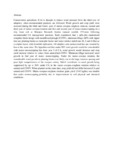Please use this identifier to cite or link to this item:
https://cris.library.msu.ac.zw//handle/11408/2991| Title: | Weed growth and crop yield responses to tillage and mulching under different crop rotation sequences in semi-arid conditions | Authors: | Mashingaidze, Nester Twomlow, S Madakadze, I. C. Mupangwa, W. Mavunganidze, Z. |
Keywords: | Conservation agriculture Weed growth Crop yield |
Issue Date: | 2017 | Publisher: | Wiley | Series/Report no.: | Soil Use and Management;Vol. 33; No. 2: p. 311–327 | Abstract: | Conservation agriculture (CA) is thought to reduce weed pressure from the third year of adoption, when recommended practices are followed. Weed growth and crop yield were assessed during the third and fourth year of maize–cowpea–sorghum rotation, second and third year of maize–cowpea rotation and first and second year of maize monocropping on a clay loam soil at Matopos Research Station (annual rainfall, 573 mm) following recommended CA management practices. Each experiment had a split-plot randomized complete block design with mouldboard plough (CONV), minimum tillage (MT) with ripper tine and planting basins as main-plot factor and maize residue mulch rate (0, 2 and 4 t/ha) as a subplot factor, with threefold replication. All subplots were surface mulched and weeded by hoe at the same time. We hypothesized that under MT weed growth would be considerable with maize monocropping but from year 3 of CA, weed growth would decrease and crop yield increase relative to values from unmulched CONV. Minimum tillage increased weed growth in 2nd year of maize monocropping. Under the maize–cowpea rotation, the considerable weed growth in planting basins was likely due to the large intrarow spacing and poor light competiveness of the cowpea variety. Mulch contributed to weed growth being suppressed by up to 36% under CA in the maize–cowpea–sorghum rotation relative to unmulched CONV. When planted on the same date, crop yield did not differ between CA and unmulched CONV. Maize–cowpea–sorghum rotation grain yield (3143 kg/ha) was double that under monocropping, probably due to improvements in soil physical and chemical conditions. | URI: | http://onlinelibrary.wiley.com/doi/10.1111/sum.12338/full http://hdl.handle.net/11408/2991 |
ISSN: | 0266-0032 |
| Appears in Collections: | Research Papers |
Files in This Item:
| File | Description | Size | Format | |
|---|---|---|---|---|
| Abstractmashingaidze.pdf | Abstract | 242.38 kB | Adobe PDF |  View/Open |
Page view(s)
86
checked on Dec 21, 2025
Download(s)
16
checked on Dec 21, 2025
Google ScholarTM
Check
Items in MSUIR are protected by copyright, with all rights reserved, unless otherwise indicated.



